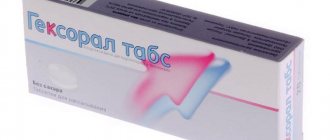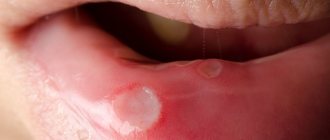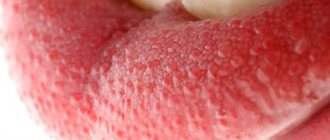What is stomatitis and what types exist?
The name of the disease indicates its exact location; translated from Latin “stoma” means mouth. Stomatitis is an inflammatory lesion of the oral mucosa (most often ulcerative). Both adults and children can get sick. But the disease affects children more often. This is due to the fact that the mucous membrane at this age is easily infected by pathogenic microflora, because the child’s body is not yet perfect, local and general protective reactions are not sufficiently developed. Statistics show that almost 80% of young children have suffered from this disease at least once.
Stomatitis is the general name for a whole group of diseases of the oral mucosa. Therefore, each of them has its own symptoms and its own treatment methods. Depending on the etiology, stomatitis is divided into several types:
- viral, including herpes - has a viral nature, infection occurs by airborne droplets. The virus can exist on objects (clothing, toys, etc.) for some time. The initial symptoms are similar to those of ARVI: lethargy, fever, runny nose, cough (not always). On the second or third day, light ulcers with a red border appear on the tongue, mucous membranes of the cheeks and lips;
- traumatic - inflammation is provoked by mechanical damage to the inner surface of the mouth, for example, a burn from a hot drink or food, a scratch from a toy stuck in the mouth, biting if the child has an incorrect bite;
- allergic – the inflammatory process is provoked by the entry into the body of a substance that causes an allergic reaction. Most often caused by drugs;
- candidiasis (fungal) - begins when the mucous membrane is infected with the fungus Candida (“thrush”). A striking symptom is a dense white coating on the tongue.
“Mom, my mouth hurts!” We talk about stomatitis in children
Is your child being capricious, refusing food, or complaining of pain in the mouth? One of the reasons for this condition may be stomatitis. Alla Aleksandrovna Zmanovskaya, a dentist at Clinic Expert in Irkutsk, told us about the signs of stomatitis in children, methods of diagnosing and treating it.
— Alla Alexandrovna, what is stomatitis?
This is an inflammation of the mucous membrane of any part of the oral cavity - lips, cheeks, tongue, palate, gums.
— Why does stomatitis occur in children?
One of the reasons for the development of stomatitis may be damage to the mucous membrane as a result of mechanical and chemical trauma. There are frequent cases of injury to the mucous membrane by sharp edges of teeth. One type of stomatitis, Bednar's aphthae, develops due to trauma to the oral cavity from a rough pacifier. The availability of household chemicals to a child can cause a chemical burn to the oral cavity.
Viral, bacterial and fungal stomatitis develop against the background of infection with pathogens of ARVI, influenza, herpes, measles, rubella, specific infections (tuberculosis, syphilis, etc.), with weakened immunity, with pathology of certain organs and systems, in particular the gastrointestinal tract , as well as for allergic reactions. Fungal stomatitis can develop due to the use of antibiotics.
— Tell us about the existing types of stomatitis in children and their differences
There are acute and chronic forms of this pathological process. Depending on the elements of tissue damage, catarrhal, ulcerative and aphthous stomatitis are distinguished. They differ from each other both in symptoms and severity, and in treatment tactics.
Acute herpetic stomatitis is a common type of disease in children aged 6 months to 3 years. During this period, children lose antibodies received from the mother while the fetus is in the womb, and their own immunity is not yet ready for an adequate response. With age, there is a decrease in the incidence of this form of stomatitis due to the development of acquired immunity after suffering various forms of herpetic infection.
Infants and children who have undergone long-term antibiotic therapy often develop candidal stomatitis.
— What are the symptoms of stomatitis in children?
Parents may notice rashes on the oral mucosa - blisters, spots, ulcers, erosions, and feel bad breath. Young children become more capricious and refuse foods that especially irritate the inflamed mucous membrane (sour, salty). An older child usually points to the place where it hurts. With more severe stomatitis in children, body temperature may increase. Detection of these signs is a good reason to immediately contact a pediatric dentist.
— What is the diagnosis of stomatitis in children based on?
To make a diagnosis, we first talk with the adults accompanying the child - we find out the complaints, clarify when and how the disease began, how long it has lasted, and what chronic pathologies the child suffers from. Then we move on to examining the oral cavity, recording all changes in the mucous membrane and teeth. An external examination of the maxillofacial area is also carried out. In severe cases of some types of stomatitis in children, rashes on the lips and enlarged regional lymph nodes can be detected.
— What methods of treating stomatitis in children are currently relevant?
Depending on the severity of the disease, local or complex treatment is used. For example, in the case of the development of stomatitis as a result of mechanical damage, it is sufficient to eliminate the action of the causative factor (avoid the use of rough nipples, grind off sharp edges of teeth, etc.), antiseptic treatment of the oral cavity and the use of drugs for regeneration of the mucous membrane against the background of complete sanitation and elimination of the damaging factor a. For chemical burns, depending on the severity, hospitalization is indicated.
For viral, bacterial and fungal stomatitis of moderate and severe severity, in addition to local treatment, antiviral, antifungal or antibacterial therapy is additionally prescribed.
For any form of stomatitis, children should limit their consumption of coarse, hard, irritating foods.
Based on how long it takes for a child’s stomatitis to go away, we can draw a conclusion about the effectiveness of the treatment used and, if necessary, adjust it. Any form of stomatitis is cured within one to two weeks. However, it should be remembered that a feature of stomatitis in an HIV-infected child is that its course, even with appropriate treatment, is delayed for more than 2 weeks.
— Alla Alexandrovna, is it possible to prevent the development of stomatitis?
Can. The main method of prevention is sanitation of the oral cavity, which involves treatment of all teeth affected by caries and its complications, regular thorough oral hygiene, disinfection of premises, household items, and toys.
If a child often has stomatitis, you should consult a dentist and pediatrician, who, if necessary, will prescribe a comprehensive examination. It is important that children receive a nutritious, balanced diet and spend a lot of time outdoors. Hardening the body and playing sports also help the body resist infections.
If you suspect or detect signs of stomatitis in a child, I recommend that you contact a pediatric dentist. By eliminating possible causes and choosing the right therapy, the doctor will be able to prevent oral inflammation from becoming chronic.
For reference:
Zmanovskaya Alla Alexandrovna
In 2015 she graduated from the Faculty of Dentistry of Irkutsk State Medical University.
In 2016, she completed her internship at the Federal State Budgetary Educational Institution ISMU in the specialty “General Dentistry”.
In 2016, she underwent professional retraining at the Federal State Budgetary Educational Institution ISMU in the specialty “Therapeutic Dentistry”, in 2022 – in the specialty “Pediatric Dentistry”.
Dentist-therapist, pediatric dentist at “Clinic Expert” Irkutsk. Receives at the address: Irkutsk st. Kozhova, 9a
Symptoms
Signs indicating that a baby is suffering from stomatitis are divided into two types: local and general. It is not difficult to recognize them, especially if the baby already knows how to speak and can tell where he feels discomfort. If a baby is sick, the main symptom is general restlessness and crying. Parents should carefully examine his mouth and make sure that there is (or is not) an inflammatory process on the mucous membrane.
Local symptoms:
- blisters, sores or plaque on the inner surface of the lips, cheeks and/or tongue, pharynx;
- marks from biting, burns or scratches;
- swelling and redness of the mucous membrane next to the lesions;
- bad breath.
Are common:
- increase in body temperature (from slight to critical);
- increased size of lymph nodes;
- refusal to eat;
- lethargy;
- moodiness;
- nervousness.
Note to parents: symptoms can manifest themselves both complexly and individually. But the presence of even one of the listed manifestations of the disease is a reason to visit a doctor.
What happens if stomatitis is not treated?
Some parents do not take their child’s stomatitis seriously, they say, “it will go away on its own.” Such an attitude towards the baby’s health can lead to serious consequences. Without treatment, the infection can spread to the skin of the face. There is also a high risk of secondary infection. And this already threatens general intoxication of the body, damage to the nervous system, etc., even death. Therefore, doctors strongly recommend that if symptoms of the disease are detected, show the child to a specialist in order to avoid negative health consequences.
Treatment with folk remedies
Alternative treatment can be a good addition to the main therapeutic prescriptions. However, only a doctor should decide how and how much stomatitis is treated in a child.
Traditional methods are not recommended for very young children. It is better not to use them before the age of 2 in order to avoid the development of serious allergic reactions, which can only aggravate the underlying disease.
Often, beekeeping products are used in folk recipes for medicinal purposes for stomatitis: honey and propolis.
- Dissolve 2 teaspoons of natural honey in the prepared decoction of chamomile flowers (1 tablespoon per glass of boiling water). Rinse your mouth with a warm solution 3-4 times a day.
- Mix a tablespoon of fresh aloe leaves with the same amount of natural honey. Apply the resulting mixture 3 times a day to areas of inflammation using a sterile cotton swab.
- Dissolve 10 drops of propolis alcohol tincture in a full glass of warm boiled water and rinse your mouth thoroughly 3 times a day after meals.
Gargling with soda and salt has proven to be a good remedy for treating stomatitis, even in young children. To prepare the solution, you need to dissolve half a teaspoon of baking soda and salt in a glass of boiled and cooled water. Rinse your mouth 4-5 times a day, especially after eating. However, it should be remembered that it is not advisable for the soda-saline solution to come into contact with open wounds on the mucous membrane.
Traditional medicine often prescribes treating stomatitis in children with burnt alum, a powder prepared from heat-treated potassium alum. To prepare the remedy, half a teaspoon of powder is dissolved in a glass of warm water until a somewhat viscous solution is obtained. Older children can rinse their mouth with this product 3-4 times a day. For babies, you can treat the mucous membranes with a swab dipped in alum solution.
Treatment of inflammatory diseases of the oral cavity with herbs has proven itself well. For this purpose, decoctions of sage, calendula, chamomile, and oak bark are used. They have a pronounced antiseptic and astringent effect. It is recommended to rinse your mouth with such herbal decoctions at least 3-4 times a day.
Treatment methods
Due to the fact that the etiology of each type of stomatitis is different, the approaches to treatment are also different. For example, a fungus needs to be fought with an antifungal drug, herpes with an antiherpes drug, allergies with an antihistamine, etc. Therefore, the main task of a doctor is to diagnose stomatitis, identify the cause of the disease and prescribe appropriate treatment. Therapy is carried out in two directions: relief of general symptoms and local effects on mucosal lesions. As a rule, the doctor prescribes medications and antiseptic treatment of the oral cavity in the form of applications and rinses.
What do doctors advise for home care?
The specialist makes a diagnosis and prescribes treatment, and the implementation of all instructions falls entirely on the shoulders of the parents. Caring for a small child with stomatitis contains many nuances. For example, during this period you should feed your baby only warm food with a mushy consistency, excluding citrus, sour and spicy foods. After eating, be sure to rinse your mouth. If the baby is still very small, then after eating you should give him a little boiled water to drink. Treatment of the oral cavity and application of gels prescribed by a doctor should be done with a special fabric fingertip or a finger wrapped in a bandage (the bandage should then be thrown away).
Important: self-medication is dangerous. Only a doctor can correctly diagnose and give the correct therapeutic recommendations.
General approaches to the treatment of childhood stomatitis
A child who experiences any symptoms of the disease must contact a specialist. It is almost impossible to cure stomatitis on your own, and delaying treatment can cause serious complications, both in newborns and older children.
- It is advisable to isolate a sick child from using common household items in the family. It is worth providing him with separate dishes, cutlery and towels. If there are other children in the family, then it is necessary to minimize contact through shared toys.
- Strict oral hygiene is recommended to prevent secondary infection and worsening of the disease. For example, a child under one year old should treat the oral mucosa with special wipes with xylitol or another antiseptic. Children over one year of age can rinse their mouths with antiseptic solutions before and after meals. To clean your teeth, you should purchase a toothbrush with soft bristles that will not injure the inflamed surface of your gums or tongue.
- When stomatitis occurs in newborns or infants, special attention is paid to the treatment of nipples, feeding bottles, pacifiers and nipples of the mother's mammary glands.
- Eating any food usually brings severe pain to the child. To reduce sensitivity, anesthetic gels and sprays are used.
- Particular attention in the effective treatment of stomatitis is given to nutrition. The food you eat should be at body temperature. All irritating, sour and spicy foods are excluded from the diet. In case of severe pain, you can offer the child to eat homogenized liquid food through a wide tube. Nutrition should be balanced and contain sufficient amounts of nutrients, as well as vitamins and minerals.
For stomatitis, Dr. Komarovsky recommends paying special attention to the microclimate of the room in which the sick baby is located. The room must be well ventilated twice a day. In winter, the air must be humidified using special humidifiers.
Methods for preventing stomatitis
- Preventative visits to the dentist (twice a year), if necessary, dental treatment
- Strengthening the immune system (regime, good nutrition, hardening)
- Maintaining oral hygiene
- Getting rid of bad habits (finger sucking, toys, pencils, etc.)
- Maintaining household hygiene (thorough cleaning of premises, washing toys)
- Timely treatment of gastrointestinal diseases
The dental network offers services for the treatment of stomatitis in children. Our specialists are highly qualified and regularly improve their skills in leading clinics in Russia and Europe. The pediatric dentist will diagnose and prescribe effective treatment. We have a system of family and cumulative discounts.
You can contact any of the branches of our center in Moscow within walking distance from metro stations:
- Art. Alekseevskaya (VDNKh district, etc. Mira), address: st. 3rd Mytishchiskaya house 3, building 2;
- Art. Shelepikha, address: Shelepikhinskaya embankment, address: building 34, building 1.
Stomatitis is a serious disease; do not expect that it will go away on its own without consequences. Remember that your child's health depends only on you. If you notice the symptoms described in the article, sign up for “Smile” dentistry and get qualified help. We are waiting for you every day without breaks and weekends.
Medicines for stomatitis in children: how to treat?
Selecting the right children's medicine for the medical treatment of stomatitis is a rather delicate process. After all, at different ages, children need to be treated differently: those drugs that are suitable for a one-month-old baby may not affect the course of the inflammatory process at all in a two-year-old child.
The same applies to the question of how long it is necessary to treat such a pathology. In infants, a one-year-old baby and a 2-year-old child, recovery times will also differ, even when using the same remedy. In any case, you should not expect quick treatment, since it takes several days to several weeks to relieve inflammatory reactions and heal damaged tissues.
Drug treatment
Drug treatment is aimed at relieving symptoms of stomatitis such as pain and inflammation, as well as accelerating the healing process of damaged tissue.
Painkillers
Since young children have a fairly low pain threshold, pain relief is the primary goal in the treatment of acute stomatitis. For this purpose, both system-wide drugs for oral administration and local agents in the form of gels are used.
Painkillers for oral administration:
- Ibuprofen is a strong drug that has a pronounced analgesic, anti-inflammatory and antipyretic effect. Its dosage is prescribed at the rate of up to 10 mg per kg of the child’s weight three times a day for no more than 5 days in a row. Can be used no earlier than 3 months of age.
- Paracetamol also relieves pain and fights high fever. For children under three years of age, it is preferable to use rectal suppositories or syrup, while older children can use tablets. The dosage is calculated based on the child’s weight (15 mg per kilogram). It is possible to use the product 3-4 times a day.
Local anesthetics:
- Cholisal is a drug with a good analgesic effect, which additionally has anti-inflammatory and antibacterial effects. Apply the gel to damaged mucous membranes 3-4 times a day before or after meals, as well as before bed. It is not advisable to use before 9 months of age.
- Kamistad - a combination of lidocaine with chamomile infusion gives a good analgesic and anti-inflammatory effect. The gel should be used 3-4 times a day, rubbing it into the area of inflammation.
- Kalgel is a combined drug in the form of a gel with antimicrobial and analgesic effects. Well relieves pain from stomatitis, gingivitis and other inflammatory diseases in the oral cavity. Use no more than 6 times a day.
Antiseptic and anti-inflammatory agents
Drugs with antiseptic properties suppress the activity of pathogenic microorganisms and have a good anti-inflammatory effect. They can be used both for rinsing the entire oral cavity and for treating individual areas of damaged oral mucosa. They are successfully used to treat stomatitis at home.
Sprays for the treatment of stomatitis:
- Hexoral is a spray with pronounced activity against pathogenic microflora. Used after meals and remains effective for up to 12 hours. It is used twice a day by briefly spraying the solution in the mouth.
- Inhalipt is a combination drug that combines a soluble form of streptocide in combination with essential oils. It has anti-inflammatory, antiseptic and minor analgesic effects. Oral irrigation is carried out 3-4 times a day until the symptoms of stomatitis disappear.
- Chlorophyllipt is a spray with an antiseptic effect. Suppresses pathogenic microflora, promotes rapid healing of ulcers. Used to irrigate the oral cavity 2-3 times a day until recovery.
Iodine-based preparations:
- Lugol is an iodine-based drug with a pronounced t effect. Used as a spray for irrigating the oral cavity and in a solution for treating damaged areas of the mucous membranes. Treatment of the affected areas is carried out 2-3 times a day using a cotton swab or by spraying a spray.
- Iodinol is another iodine-based medicine. It has low toxicity and is destructive to most microorganisms and fungi. It is not used for stomatitis in children under one year of age, as there is a high risk of swallowing the drug. For children aged 1.5 years and older, it can be used as a mouth rinse (5 ml of solution is diluted in 50 ml of warm water). The procedure is carried out 4-5 times a day, no more than 5 days in a row.
Mouth rinse solutions:
- Stomatidin is a powerful antiseptic with a pronounced anti-inflammatory effect. Used for rinsing the mouth or treating damaged surfaces with an undiluted solution. The procedure is carried out 2-4 times a day, with an interval of at least 4 hours between them. The course of treatment usually lasts 7 days.
- Miramistin is a drug with a broad spectrum of action against pathogenic flora. It eliminates signs of inflammation well. It is used in the form of a solution, which is used to treat areas of stomatitis, or in the form of aerosols, which are applied to the entire oral cavity. The frequency of the procedure is 2-3 times, the duration of the course of treatment is 7 days.
- Chlorhexidine is a solution with an antiseptic effect. Suppresses the growth of pathogenic bacteria and helps the body fight inflammation. Children over 7 months of age can treat the oral cavity with a solution diluted with boiled water (the ratio of water to the drug is 1:1), children over 5 years old can rinse their mouth with a regular solution. Repeat the treatment procedure 2-4 times a day until the symptoms of stomatitis disappear.
- Furacilin is a fairly broad-spectrum antiseptic. Does not cause irritation to mucous membranes. Available in the form of a ready-made solution or tablets. To prepare the solution at home, you need to dissolve 1 tablet of furatsilin in 500 ml of warm boiled water. You need to rinse your mouth with this solution 3-4 times a day until complete recovery. For small children under 2 years of age, the drug can be applied with a gauze swab directly to the inflamed area.
- Hydrogen peroxide as an antiseptic can be used to treat stomatitis in older children. The use of such a product must be careful, since it is toxic and can cause serious burns to the mucous membranes. To prepare a rinse solution, dissolve 1 teaspoon of peroxide in 100 ml of water. Carry out the procedure three times a day after meals. The course of such treatment is 5-7 days.
- Stomatofit is a plant-based drug that has bactericidal, anti-inflammatory and tanning effects. To rinse the mouth, 10 ml of solution is mixed with a quarter glass of water. Treatment is carried out 3-4 times a day until complete recovery.
Anti-inflammatory and antiseptic gels:
- Metrogyl denta is a combined remedy for the treatment of inflammatory diseases of the oral cavity. The gel is applied to areas of the mucous membrane affected by stomatitis three times a day. The course of treatment is approximately 7 days.
Vitamin and regenerating products
Vitamins and wound-healing agents in the treatment of stomatitis are used after acute symptoms have subsided. Their main task is to speed up the regeneration processes in damaged tissues, maximally restore their metabolism and adequate blood supply. Such drugs are most often used topically in the form of oils, gels, and ointments.
The most commonly prescribed drugs are:
- Aekol is an oil solution of vitamins A, E, K and provitamin A. The product is applied directly to the affected area on a gauze bandage once every 48 hours. The treatment course continues until the mucous membrane is completely restored.
- Vinilin - has an anti-inflammatory effect and at the same time stimulates the healing of damage to the mucous membrane. Apply the drug using a cotton swab directly to the affected area after each meal and before bedtime until the clinical manifestations completely disappear. According to the instructions, it can be used after one year of age.
- Solcoseryl is a paste that stimulates the processes of epithelization of damaged tissues, promoting the rapid healing of ulcerative defects in stomatitis. For children, it is necessary to apply the drug 3-4 times a day after thoroughly rinsing the mouth with clean boiled water and drying the inflamed areas with sterile cotton pads.
- Sea buckthorn oil is a natural remedy that has a regenerating effect. After the acute symptoms have subsided, apply with a sterile cotton swab to the inflamed areas twice a day.











